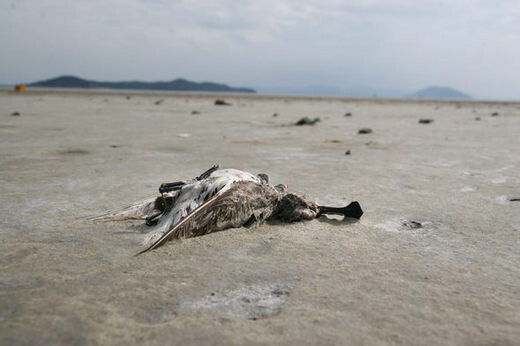hankyoreh
Links to other country sites 다른 나라 사이트 링크
Tidal flats, slowly dying, no longer a haven for birds

Nial Moores, director of Birds Korea, an ecology group, has taken part in research and activities to protect birds for eight years. But he is nervous these days, as he is witnessing the signs of impending disaster for shorebirds at the Saemangeum tidal flats.
This is the time when Great Knots flying from the Siberian tundra usually cover the sky over the Saemangeum wetlands. Moores, however, said, "I have observed the area from last week, but there were less than 100 birds. There should be about 30,000-50,000 birds." At the mouth of the Geumgang River, he could only see some 600 birds. The cause is that shellfish, the main food for the birds, almost disappeared here in April due to the Seamangeum tidal flats reclamation project. "Great Knots, in general, store extra food so that they can fly hundreds of additional kilometers. It seems that they have moved to the mouth of Yangtze River for food," added Moores.
Great Knots are long-distance migratory birds, making the journey to and from Australia, where they pass the winter, and Siberia, their breeding ground. About a third of the entire world population of the Great Knot visits Saemangeum, which is the midway point in their journey. Saemangeum was once abundant in shellfish, but a government land reclamation project there has killed much of the sea life.
If these birds stay at Saemangeum comfortably for 3-5 weeks, they can fly to their destination and breed without trouble. However, this is not the case. Moores predicts, "The birds will be in trouble in spring of next year in particular." Great Knots which go north to Siberia fly 5,000-8,000 km without rest to Saemangeum. Where can these exhausted birds find food?"
Regarding the problem, the Ministry of Agriculture and Forestry said, "Even if the Saemangeum tidal flats disappear, there will be no problem because the birds can move to nearby Gomso Bay and to the mouth of the Geumgang River."
However, international researchers dispute the ministry’s ideas. Birds Korea, jointly with Australasian Wader Studies Group, researched shorebirds around Saemangeum in April and May. In a recent report, they said that "there is no evidence showing that the shorebirds have since moved to Gomso Bay or to the mouth of the Geumgang River." The Gomso Bay still is shunned by birds, and there was no significant change in the Geumgang River area. The shorebirds were enduring...by eating dying shellfish. The report forecast, "The situation will be worse next year."
"Even though there is no food for them at Saemangeum," Moores explained, "the birds won’t die immediately. But the number of birds will be sharply reduced because [as a result of the shortage] more and more birds will die during migration and more birds will fail at breeding."
The report urged the government to increase the flow of sea water to the flats and to stop the reclamation project at the Geumgang River area, which has become the most important visiting place of the shorebirds on the West Sea.
Editorial・opinion
![[Column] Park Geun-hye déjà vu in Yoon Suk-yeol [Column] Park Geun-hye déjà vu in Yoon Suk-yeol](https://flexible.img.hani.co.kr/flexible/normal/500/300/imgdb/original/2024/0424/651713945113788.jpg) [Column] Park Geun-hye déjà vu in Yoon Suk-yeol
[Column] Park Geun-hye déjà vu in Yoon Suk-yeol![[Editorial] New weight of N. Korea’s nuclear threats makes dialogue all the more urgent [Editorial] New weight of N. Korea’s nuclear threats makes dialogue all the more urgent](https://flexible.img.hani.co.kr/flexible/normal/500/300/imgdb/original/2024/0424/7317139454662664.jpg) [Editorial] New weight of N. Korea’s nuclear threats makes dialogue all the more urgent
[Editorial] New weight of N. Korea’s nuclear threats makes dialogue all the more urgent- [Guest essay] The real reason Korea’s new right wants to dub Rhee a founding father
- [Column] ‘Choson’: Is it time we start referring to N. Korea in its own terms?
- [Editorial] Japan’s rewriting of history with Korea has gone too far
- [Column] The president’s questionable capacity for dialogue
- [Column] Are chaebol firms just pizza pies for families to divvy up as they please?
- [Column] Has Korea, too, crossed the Rubicon on China?
- [Correspondent’s column] In Japan’s alliance with US, echoes of its past alliances with UK
- [Editorial] Does Yoon think the Korean public is wrong?
Most viewed articles
- 1[Column] Park Geun-hye déjà vu in Yoon Suk-yeol
- 2Thursday to mark start of resignations by senior doctors amid standoff with government
- 3N. Korean hackers breached 10 defense contractors in South for months, police say
- 4[Editorial] New weight of N. Korea’s nuclear threats makes dialogue all the more urgent
- 5Will NewJeans end up collateral damage in internal feud at K-pop juggernaut Hybe?
- 6Kim Jong-un expressed ‘satisfaction’ with nuclear counterstrike drill directed at South
- 7[Editorial] Japan’s rewriting of history with Korea has gone too far
- 8[Column] ‘Choson’: Is it time we start referring to N. Korea in its own terms?
- 9[Cine feature] A new shift in the Korean film investment and distribution market
- 10[Column] The clock is ticking for Korea’s first lady